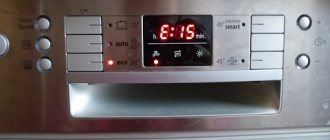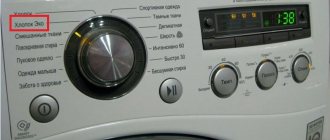Dishwashers remove dirt from the surface of dishes or pots with a stream of hot water mixed with a cleaning solution. To heat the working fluid to the required temperature, an electric heating element is used, which has a limited resource. The owner can independently select a heating element for a Bosch dishwasher and repair the equipment.
What is needed for replacement
The thermoblock is one of the most difficult to repair and vulnerable to mechanical damage parts. Repairing a heating element for a dishwasher yourself is extremely difficult. To do this, you will need to seek the help of specialists, professional repairmen. It is often easier to replace the heating element with a new one. To do this, you only need a certain set of tools:
- Flathead and Phillips screwdrivers
- Multimeter for measurements and troubleshooting
- Pliers
- Awl
Ready! You can start disassembling. Experts advise starting repair work only if you are completely sure that the heating element is faulty. In this case, depending on the model, you will have to replace the heating element or the entire thermoblock. For example, for dishwashers from manufacturers Bosch, Electrolux or Indesit, the entire thermoblock will have to be replaced.
The thermoblock consists of sockets and connections for the sensor. The body of the spare part is made of plastic. If there are fasteners, you can unscrew these parts and remove the faulty heating element. If there are none, then you will have to replace the entire thermoblock. The price of the heating block depends on the model and series of the dishwasher. Usually it varies around 1000-4000 rubles.
We also advise you not to limit yourself to inspecting and repairing the thermoblock. When examining the “insides” of the dishwasher, you can find particles of mineral salts deposited on pipes and spare parts, or dirt that has clogged the filters. In the future, this will allow you to significantly save time and money if problems are detected, for example, problems with the discharge of used water.
Step-by-step instructions for replacing the heating block
All dishwashers have a significant drawback - new models are more vulnerable and prone to breakdown than older ones. However, if a heating element is damaged, repair work should begin immediately. You can buy original spare parts in any suitable store in your city, or order online. Once you have the necessary components, get started.
We proceed according to the following scheme:
Unplug the dishwasher. Shut off the water supply through the injection hose. Remove dishes and trays from inside the machine for complete freedom of action. Unscrew all hoses. Remember: there may be dirty water left in the drain tank
Be careful not to flood the floor. At the very bottom of the dishwasher there is a sprayer for supplying water mixed with alkali. Gently pull it up and remove it. The next step is to remove the filter
It looks like a glass. Unscrew it carefully. The filtration system also includes a metal mesh. It is made of steel that is not subject to corrosion. Delete it too. Now comes the most important step. You have to unscrew the five screws that secure the heating block and pipes. Now everything is ready to replace the thermoblock. The next step is to directly replace the faulty part. We follow the previously stated instructions: first of all, turn the dishwasher upside down. Unscrew the back wall and pull out the panel. This way you will get to the heating element and can start replacing. Next you have to disconnect the pump. Squeeze it with your hands and turn it half a turn clockwise. Next, pull to the side. Ready! The pump has been removed. Now disconnect the sensor. If your dishwasher belongs to the three previously mentioned models, where the heating element and sensor are replaced along with the thermal block, then remove the entire thermal block in which the flow-through heating element for your dishwasher is mounted. The part is secured at the bottom with a rubber latch. You will have to search for it blindly, but it is very easy to disconnect. Now all that remains is to disconnect the bells and plugs of the sensors.
Ready! The disassembly operation can be considered completed. You can repair the heating element in the dishwasher, or replace it with a new one. Now all that’s left to do is assemble the dishwasher in reverse order. The matter is simple and will not take much time. But the water heating system in the dishwasher will now be adjusted.
Step-by-step instructions for replacing the heating element
Have you decided to replace a faulty heating element in your dishwasher yourself?
Prepare the following set of necessary tools:
- 2 screwdrivers – flat and Phillips;
- screwdriver;
- multimeter or ohmmeter;
- pliers and awl.
The algorithm for independently replacing an electric heating element is as follows.
Step No. 1 - checking the new TEN
Check the serviceability of the new heater on a measuring device: the resistance reading should not be higher than 20-30 Ohms.
If it is more, then there is a break in the spiral; if the resistance is normal, then the part can be safely installed to replace the damaged one.
When checking the parameter readings using a multimeter, you need to check the current condition of the temperature sensor, inspect the wiring and contacts to ensure they are not damaged
Step No. 2 - dismantling the trays and lower rocker arm
Open the machine's hopper door and remove the dish trays, unplug the household appliance, and remove the hoses. Pull upward to remove the plastic spray arm and stainless steel mesh filter cup.
Now you need to remove the lower rocker arm: to do this, simply grab the part and lift it up.
When the machine has reached the desired temperature, it turns on the pump, which forces water into the rotating rocker arms - they need to be dismantled
Step No. 3 - removing the pipe and rear panel
Release the pipe connected to the heating element - use a screwdriver or screwdriver to unscrew the 5 screws that support the pipe connected with clamps to the flow-through electric heater, then turn the housing over so that the bottom is on top.
Now remove the back panel. If the car has a retractable wall instead, then pull it out. The heating element is connected to the pump.
To disconnect it, grab it and turn it half a turn to the right, pull it to the side, then the pump will be in your hands. All that remains is to remove the sensor from it.
The sensors are installed in dishwashers of the 2nd and 3rd generation of production and differ in different functional properties. When removing them, act carefully and remember the installation locations
Step No. 4 - dismantling the burnt heating element
Remove the fasteners holding the heating element. In Bosch dishwashers, the heating elements are fixed from below with rubber fasteners. You need to put your hand under the body and disconnect them.
In the process, you will need to use an awl to pick up the plastic clamps holding the pipes
If you accidentally damage them, you can replace them with new ones, but it’s better to act carefully
Remove the burnt TEN. Disconnect the installation plugs of the sensors, pipes and remove the burnt and depressurized heating element.
If the pipes do not give in immediately, grab them with pliers, acting with extreme caution so as not to inadvertently damage the plastic parts: today their cost is quite high
Step No. 5 - installation of a new heater-heater
Replacing the heater with a new one will not take much time
It is important to act extremely carefully, assembling all elements in the reverse order of the dismantling procedure. This replacement process can be clearly seen in the videos shown in the last block of the article. We also recommend that you read the instructions for installing and connecting a Bosch brand dishwasher yourself, which will help you easily assemble the machine after repair and correctly connect it to communications
We also recommend that you read the instructions for installing and connecting a Bosch brand dishwasher yourself, which will help you easily assemble the machine after repair and correctly connect it to communications.
After installation, continue to monitor the performance of the heating element by regularly descaling it by mechanical cleaning or using chemical ingredients.
In addition to the TEN, other working components of the equipment require maintenance. Therefore, in order to extend the life of your dishwasher, it is advisable to carry out regular maintenance.
Replacing the heating element
Before replacing the heating element of the dishwasher, you will need to disconnect the connection hose connected to the water supply line and disconnect the hose for draining the waste liquid into the sewer. Disassembly of the housing and replacement of components is carried out only with the equipment de-energized. To complete the job, you will need a set of Phillips and flathead screwdrivers, a test tool, pliers and a set of wrenches or sockets.
Sequence of actions when replacing the heater on a Bosch machine:
- Open the front door of the machine and remove the dish trays from the washing chamber.
- Remove the plastic liquid spray arms and remove the filter block from the seat on the bottom of the chamber.
- If the machine is built into a kitchen unit, then you need to unscrew the fastening screws on the sides and the housing lid.
- Pull up the lower spray arm, which is held in the landing channel by a retainer with a spring.
- Remove the plastic pipe connected to the heater (located in the cavity of the washing chamber).
- Move the dishwasher out into the open and remove the side covers. On built-in appliances, it is enough to lift the soundproofing panels and remove the plastic shields.
- Place the equipment on the back wall, having previously placed a layer of damping material.
- Remove the lower housing with adjustable feet, and then disconnect the water hose from the heater block. When the main line is turned off, the remaining water inside the hose and pump flows out. Sticky hoses are removed with pliers; applying force is prohibited due to the risk of breaking the pipes.
- Disconnect the connection cables and unscrew the screws or bolts (depending on the modification) securing the heater body. To hold electrical cords, plastic fasteners are used, which are removed with wire cutters or unfastened with an awl.
- After installing the new heater, assembly is performed in the reverse order.
- Test the operation of equipment in various modes.
Before replacing the heating element of a Bosch dishwasher, it is recommended to measure the resistance of the heating element in the new product. The manufacturer unifies the design of the product, so the winding resistance is lower than the required value. For example, a product with a power of 2080 W with a supply voltage of 230 V should have a resistance of 25 Ohms, and the value measured by the tester is 18 Ohms. By reducing resistance, water heating accelerates, but the durability and reliability of the product decreases.
To increase the resistance, the technological jumper is removed, separating part of the heating coil. To perform the work, you will need to dismantle the pump housing mounted on the heater. The disadvantage of the procedure is the loss of the warranty on the new unit and an increase in operating cycle time due to a decrease in the intensity of water heating.
Signs and causes of heating element failure
There are indirect reasons for determining problems with a tubular electric heater. Some modern dishwasher models notify owners of problems through an error indicator on the screen. The following models are equipped with a comprehensive automatic diagnostic program:
- Hotpoint Ariston;
- Indesit;
- Siemens.
Reasons for failure of the heating device
Users of dishwashers are forced to change the electric heater due to burnout of the spiral part and an electrical short in the lower part of the pipes. Most often, flow-through heating elements become unusable.
The following reasons for electric heater failure are identified:
- there is a leak;
- a sharp surge in voltage in the electrical supply network;
- dirty filter;
- incorrect operating conditions for the dishwasher;
- wear and accumulation of at least two millimeters of scale on the element.
Ten in the dishwasher
Causes of breakdowns
Causes of damage to the dishwasher heating unit:
- The use of water with increased hardness leads to salt deposits on Bosch heating elements. A layer of foreign matter impairs heat transfer and causes overheating of the coil, which burns out over time.
- Deposits of salt and cleaning agents during prolonged contact with metal cause corrosion of elements; water penetrating inside the tube leads to a short circuit and failure of the dishwasher.
- Burnout of the coil or electronic components due to a power surge.
- Natural wear of the graphite bushings on which the pump motor rotor rotates.
Connection to water supply
The next stage of installation is connecting to the water supply. The dishwasher needs cold water. To do this, we shut off the supply from the riser or close the common house tap, cut in a tee and install a tap that cuts off the water supply to the dishwasher. If this is an end pipe, we simply install a single tap here. You can also use a three-piece with an already built-in faucet - these can be purchased at any plumbing store.
During the installation of the dishwasher, we seal all connections with fum tape, winding it in the direction of the thread. We tighten the nuts, check the tightness of the tap (the valve must be closed), and then connect the supply hose to the tee. There is no need to open the tap at the installation stage; all tests are carried out later, when everything is ready.
Is it possible to connect a dishwasher to a hot water pipe? During the installation process, many people, in an effort to save on electricity, want to connect to the hot water supply. There really is such a possibility, but before that you need to open the technical specifications of the purchased device and make sure that Bosch specialists allow the supply of hot water (as a rule, the maximum temperature is limited to +60 degrees).
Please note that if the passport contains a note that the maximum inlet temperature is +20 degrees, you cannot connect the Bosch dishwasher to a hot water supply - such an installation will void the warranty. Installing a dishwasher connected to a hot water riser is done in the same way as to a cold water riser. But you must remember that the quality of hot water supply in our country is far from ideal
If you make installations this way, be sure to ensure reliable filtration. Otherwise, you will be subject to loss of warranty, and possibly the purchase of spare parts for Bosch PM
But you must remember that the quality of hot water supply in our country is far from ideal. If you make installations this way, be sure to ensure reliable filtration. Otherwise, you will be subject to loss of warranty, and possibly the purchase of spare parts for Bosch PM
Installing a dishwasher connected to a hot water riser is done in the same way as to a cold water riser. But you must remember that the quality of hot water supply in our country is far from ideal. If you make installations this way, be sure to ensure reliable filtration. Otherwise, you will be subject to loss of warranty, and possibly the purchase of spare parts for Bosch PM.
Another disadvantage of this installation is that hot water from the tap does not start flowing immediately, but with some delay. Remember this when connecting to communications.
Where is the heating element located and how to change it yourself
So, you have correctly identified the faulty heating element, bought a new one and are now ready to replace it yourself. To do this, you will need a small set of tools that can be found in every home: flat and Phillips screwdrivers, ohmmeter, screwdriver, awl, pliers.
First you need to make sure that the new heating element really works. An ohmmeter will help with this; the resistance should not be higher than 25-30 ohms. If everything is in order, then:
- Unplug the dishwasher;
- Take out all the “internals”: dish trays, filter, sprinkler, hoses, etc.;
- The next step is to get rid of the spinning rocker arm. This is the lower part of the bunker, where heated water is pumped using a pump.
- Now you can see the pipe connected to the faulty heating element. Using a screwdriver, unscrew all the fixing screws (usually there are five of them) and turn the case over so that the bottom is on top;
- Get rid of the back panel. In some models, a retractable wall is installed instead; remove it completely;
- Next you will see a heating element that connects to the pump. It detaches with a slight half-turn to the right, after which the part must be pulled towards you in order to finally remove it. The sensor should also be disconnected;
- Remove the fasteners from the heating element. An awl will help to carefully pry them off;
- Now you can dismantle the faulty heating element by disconnecting the remaining pipes and plugs;
- Install the new heating element in reverse order.
Replacing the heating element of a dishwasher cannot be called such a complicated procedure, and all steps can be performed independently and at home. But if you are not confident in your abilities, we advise you to trust the repair or replacement of dishwasher spare parts to specialists.
Replacing the heating element in a dishwasher
There is no more important part in a dishwasher than the heating element. It promotes water heating and thermoregulation. Therefore, if a breakdown occurs, you should urgently replace the heating element with a new one.
We’ll tell you why this happens and how to make the replacement yourself right now.
Therefore, if a breakdown occurs, you should urgently replace the heating element with a new one. We’ll tell you why this happens and how to make the replacement yourself right now.
Causes of malfunction and diagnostics
If you believe the reviews of owners of dishwashers of popular brands (Indesit, Bosch, LG, etc.), then the cause of heating element failure is most often a short circuit, as well as burnout of the spiral thread.
Also, the heating element can burn out due to a leak, major filter clogging, power surges, a scale layer of more than 3 mm and improper operation.
This is why we so often advise you to carefully study the rules for using equipment and regularly clean the filters yourself.
note
Thanks to timely care of your dishwasher, you can avoid many problems, including burnout of the heating element.
It is not difficult to diagnose a breakdown; in practice, the dishwasher simply stops heating the water; this will also be indicated by the temperature sensor readings.
It is possible to stop the program in the middle of the process or, on the contrary, “endless washing”. All this indicates a malfunction of the heating element.
How to choose a new heating element
First of all, open the documentation for your dishwasher (or the label on the case) and find out the exact model name. If you lose documents, you can find information on the Internet.
But it would be fair to talk about the differences between one heating element and another.
For example, electric instantaneous heaters quickly heat water to the required temperature, but at the same time they waste too much electricity.
These are used in Bosch dishwashers. Craftsmen consider second heaters (dry) to be of higher quality and more durable, since they do not come into contact with water.
Also, when choosing a heating element, it is important that it meets the power and voltage requirements, the connection of contacts and the diameter of your model
Where is the heating element located and how to change it yourself
So, you have correctly identified the faulty heating element, bought a new one and are now ready to replace it yourself. To do this, you will need a small set of tools that can be found in every home: flat and Phillips screwdrivers, ohmmeter, screwdriver, awl, pliers.
First you need to make sure that the new heating element really works. An ohmmeter will help with this; the resistance should not be higher than 25-30 ohms. If everything is in order, then:
- Unplug the dishwasher;
- Take out all the “internals”: dish trays, filter, sprinkler, hoses, etc.;
- The next step is to get rid of the spinning rocker arm. This is the lower part of the bunker, where heated water is pumped using a pump.
- Now you can see the pipe connected to the faulty heating element. Using a screwdriver, unscrew all the fixing screws (usually there are five of them) and turn the case over so that the bottom is on top;
- Get rid of the back panel. In some models, a retractable wall is installed instead; remove it completely;
- Next you will see a heating element that connects to the pump. It detaches with a slight half-turn to the right, after which the part must be pulled towards you in order to finally remove it. The sensor should also be disconnected;
- Remove the fasteners from the heating element. An awl will help to carefully pry them off;
- Now you can dismantle the faulty heating element by disconnecting the remaining pipes and plugs;
- Install the new heating element in reverse order.
Replacing the heating element of a dishwasher cannot be called such a complicated procedure, and all steps can be performed independently and at home. But if you are not confident in your abilities, we advise you to trust the repair or replacement of dishwasher spare parts to specialists.
What does this node look like?
In modern dishwashers from Siemens and others, the design provides for the complete replacement of faulty components with new ones in most cases. The heater on most modern brands is removable.
However, it is not always possible to change the heating element separately from other components. For example, in Bosch, Electrolux or Indesit machines it is not possible to make a replacement separately. In the cases under consideration, this can only be done together with a heating block. However, there are also brands where, for repairs, it is enough to replace the old heating element with a new one without additional effort.
The block in question is a plastic case in which there are outlets for pipes and outputs for heater sensors.
It is important to understand that if for a given dishwasher model it is stipulated that the heating element can be changed separately, then fastening elements can be visually detected on its plastic body. If it is changed together with other components, then its separate heater mounts will be provided
How to identify a malfunction
Almost all dishwashers are equipped with sensors that signal a technical malfunction of the equipment. If it is not there or for some reason it does not work, then a malfunction of the heating element for the dishwasher can be identified by several signs:
- The water in the dishwasher does not heat up;
- heating is carried out in insufficient quantities.
You can also check whether the flow heating unit is working properly using special equipment - a multimeter or voltmeter.
Water heater device
The electric heater installed in the body of the dishwasher belongs to the category of water heating elements, providing stable heating of circulating water up to +100 °C. Some models may be equipped with thermostats.
Electric heating device TEN for dishwasher. This is a special tube filled with a heat-capacity insulator, in the center of which there is a nichrome thread (spiral)
The tubular heating element contains an electrically conductive spiral, which transmits the design power to the entire outer surface of the heating module.
The main components of the heating element include:
- a tube;
- heating element;
- contacts;
- insulating layer.
The thermoelectric segment of the heating element is available in a variety of designs. There are practically no disadvantages in the devices, except for the large area for installation and the need for repairs if the spiral burns out.
The pump pumps water into the dishwasher through the top of the heating element. This is how the water is heated to the desired dishwashing temperature, which is controlled by a sensor.
Electric heaters for dishwashers with a tubular design are produced by industry with the following parameters:
- power – 15 W-15 kW;
- voltage – 12 V-380 V;
- length – 250-630 mm;
- external diameter – 6.0-24.0 mm.
If you have a 3rd generation Bosch machine, then it contains an improved pumping motor with a heating element built into it.
Heating elements for BOSCH dishwashers
Prices for spare parts and accessories are valid only for the online store
Product code:
652216
Heating element (heater) for dishwasher Bosch (Bosch), Siemens (Siemens)
In stock 11320₽
Buy
Flow-through heater for dishwasher.
Heating element (heater) for dishwasher Bosch (Bosch), Siemens (Siemens)
Heating element (heater) for dishwasher Bosch (Bosch), Siemens (Siemens)
Heating element (heater) for dishwasher Bosch (Bosch), Siemens (Siemens)
Product code:
498623
Heating element (heater) for dishwasher Bosch (Bosch), Siemens (Siemens)
In stock 11880₽
Buy
Flow type heater for dishwasher.
Product code:
488856
Heating element (heating element) for dishwasher Bosch (Bosch), Siemens (Siemens), Neff (Neff)
In stock 13280₽
Buy
Flow-through heater for dishwasher.
Product code:
483257
Flow-through heater (TEH) for Bosch dishwasher (Bosch)
In stock 12240₽
Buy
Flow-through heater for dishwasher.
Heating element (heating element) for dishwasher Bosch (Bosch), Siemens (Siemens) 1500W
Heating element (heating element) for dishwasher Bosch (Bosch), Siemens (Siemens) 1500W
Product code:
658791
Heating element (heating element) for dishwasher Bosch (Bosch), Siemens (Siemens) 1500W
In stock 11070₽
Buy
Flow-through heater for dishwasher.
Heating elements are heating elements used to heat water in dishwashers. Tap water has a fairly high hardness, this has a detrimental effect on the operating properties of equipment, including heating elements. When heated, heavy particles are deposited on the surface of the heating element. Such scale reduces the heating efficiency and leads to its failure in the future. The part cannot be repaired; to restore the functionality of your equipment, you need to change the heating element.
Ordering a new heating element for a dishwasher is very simple - just call the following numbers: Moscow and Moscow Region; Regions. Replacing a heating element is a complex and time-consuming process. It is not recommended to resort to such repairs on your own, especially if you do not have enough knowledge and skills to troubleshoot such faults. Call a specialist from ZIP-M Retail. We take a professional and responsible approach to solving any problems; we will eliminate faults in the shortest possible time and with maximum quality. After repair, your dishwasher will work like new!
Preparation for dismantling
Replacing a heating element in a Bosch SM is not the most difficult task. You can solve it yourself. What will you need? Tools, technical skills and patience, since disassembling an SMA is a slow and difficult task. Before changing the heating element in your Bosch washing machine, stock up on the following tools:
- screwdrivers - flat and figured;
- bit key;
- Torex type bat - size 10 mm;
- tester - measure resistance.
Buy a replacement part in advance. But take only the original heater. Tell the consultant the model of your washing machine, and he will select the appropriate option.
You can also find out exactly which heater you need after dismantling the part - there is a marking on it, which will help you look for the original spare part. The cost of original spare parts is quite high - about 1,500 rubles.
Internal organization
All spare parts and control elements are installed inside the bosch dishwasher body. The main details of this system are:
- A flow valve for water intake, which is equipped with an inlet system, controlled by a microcontroller.
- A filtration mechanism that cleans water from small parts of food and other debris.
- A drainage system consisting of a drainage pipe connected to a drainage system and a sump pump. It works on the same principles as the Bosch washing machine.
- Float-type blocker, protective system of the dishwasher from various leaks. It is a cylindrical plastic container that closes contacts when floating up. This happens when too much water is taken.
How to get to the heater?
Having found out where the heating element is located in Bosch machines, many users refuse to dismantle and repair it themselves. Disassembling the SMA takes a lot of time. Sequencing:
- The washing machine must be disconnected from water, sewerage and electricity. It is pulled out into free space to make it easier to disassemble.
- Use a Phillips screwdriver to unscrew the screws that hold the top cover in place.
- Remove the lid and then take out the powder container.
- Behind the container you will see two screws - these also need to be unscrewed. Now you can dismantle the control panel. Do this very carefully, otherwise you may tear off the wires. Place the panel on top - in place of the lid.
- Now you need to remove the base panel. It happens that it is attached by means of latches, then use a flat-head screwdriver to carefully unfasten the cover.
- Having opened the door, bend the cuff and proceed to removing the clamp. The cuff is tucked inside.
- All that remains is to unscrew the screw connections that secure the door.
- Remove the lock by unscrewing the 2 screws. Disconnect the wires going to the lock.
That's it, the front panel can be removed. We have gained access to the element we are interested in; all that remains is to find out how to remove the heating element and how to replace it.
Part replacement
The heating element system is located quite close to other control units. It is this circumstance that makes replacing the heating element in an appliance such as a dishwasher quite a troublesome task. To successfully replace your dishwasher heating element, follow these instructions:
- Open the hopper panel and remove the dish tray.
- Disconnect the unit from the electrical network and disconnect all connections.
- Remove the plastic irrigation mechanism located at the bottom of the dishwasher.
- There should be a plastic cylinder next to it. This is a filter, remove it.
- Remove the steel net located below.
- Remove the five screws securing the hose and heater flow blog.
- Install the unit on the top panel, providing free access to the bottom.
- Remove the back panel.
- Remove the pump. To do this, unscrew it clockwise and then gently pull it to the side. Remember: it is enough to turn it half a turn, do not make sudden movements. Remove the temperature sensor and set the pump aside.
- The heating element is attached to the bottom of the machine with a rubber element. It comes off quite easily.
- Remove the rubber fasteners, disconnect the hoses and wiring. Remove the failed heating element from the system and replace it with a new one.
Reassemble the machine in reverse order, following the instructions exactly.
The heating element is called the heart of the dishwasher, and this statement is not far from the truth. Critical damage can cause irreparable damage to the entire device, as well as lead to leaks and big troubles. Monitor its performance, descale it regularly and replace it if necessary. The heating element installation process will not take much time, and timely intervention will save you from even bigger problems.
What else is important to remember when using dishwashers?
It is best to prevent any breakdown, and this directly depends on how correctly you operate your household appliances
It is very important to carry out regular cleaning of the device, which will preserve your kitchen appliances for a long time
Be sure to use your dishwasher regularly, since during periods of prolonged inactivity, bacteria can form inside the unit, which will negatively affect the health of your family. This appliance should only be cleaned when it is completely free of detergent and dishware residues. The first thing to check is the rotating sprayers, because there should be no blockages in them: very often these small holes become clogged with small debris from food and other things. Carefully check and remove debris from all elements of the machine; you can use thin tweezers or a toothpick for this. Be sure to wipe all doors and gaskets, you can do this with detergent, and an old toothbrush can help effectively clean hard-to-reach places
Treat the spaces between the gaskets well. Pay attention to the bottom of the door, since this area in many devices is dead and water does not enter here. A damp cloth can easily remove all debris and other contaminants. Pay special attention to the area at the bottom of the unit around the drain: to gain full access, remove the baskets and carefully remove all solids and other debris.
To protect yourself from injury, unplug the appliance before cleaning. Unfortunately, none of us are immune from absurd accidents that can result in breakdowns. If you need to replace the heating element for a Bosch dishwasher, then immediately think: can you handle the repair yourself, or is it better to use the help of a specialist.
https://youtube.com/watch?v=OpN1K-eaPpc
Step-by-step instructions for prevention
The normal operation of the dishwasher depends on the condition of all its components. In order to create the necessary working conditions for them, it is necessary to periodically service the machine and apply preventive measures. Let's take a closer look at them.
Cleaning filters
Despite the requirement to manually remove food residues from dishes, a large amount of small organic matter still penetrates into the machine. These particles accumulate in filters, reducing their ability to pass water. Therefore, periodic inspection and cleaning of filters is required.
Typically, two filters are installed in the PMM - inlet and drainage. Their locations are indicated in the instructions, since the user must clean them periodically.
Removed filters are cleaned with soapy water or soda; limescale can be removed with citric acid. After cleaning, the filters are put back in place.
High-quality household chemicals
The main factor that has a negative impact on dishwasher parts is water.
If it is too hard, contains a large amount of suspensions and small particles, limescale will appear on the surface of the heater and other components.
If cheap household chemicals are used, you cannot expect high-quality and long-lasting work. To maintain the performance and increase the service life of the machine, it is necessary to use specialized products that remove lime deposits and help clean the critical components of the machine.
Correct mode of operation
To keep the machine in good condition, it is necessary to ensure its optimal operating mode. This means not only the correct choice of program, but also the frequency of use and the amount of load.
Loading rates are indicated in the instructions and must be strictly followed. The choice of mode (cycle, program) is made in accordance with the number of dishes, the degree of contamination, and the shape of the items.
Before starting operation, you should carefully study the user manual and understand which programs should be used for certain situations. Proper use of your machine will keep it in good condition for many years.
Find out everything you need to know about dishwasher water in this section.
Diagnosis of failure
Before carrying out work, you should verify the causes of the malfunction. This cannot always be done using a standard self-diagnosis system. There are situations when there is no indication of the type of malfunction, but the device does not work. In this case, you will have to check the serviceability of the temperature sensor manually. To do this you need:
- on a free-standing machine, open the back wall;
- conduct a visual inspection of the sensor and contacts for traces of burning and/or melting;
- test it with a multimeter;
- if the device is built-in, you will have to turn it upside down, remove the bottom panel and perform the same steps.
All measurements should be carried out on a dry pump. A working electric heater will produce a resistance of 21/22 ohms. If there are problems, it will correspond to infinity, which is a sure sign of the need for repair.
Design and principle of operation
A heating element is an electrical device that heats liquid with a built-in spiral made of a special material. The conductive element is located in a sealed tube, which is isolated from the machine body. The heater is placed in a water jacket, and an electric vane pump is used to circulate the liquid. The joint line between the parts is sealed with a rubber gasket, which prevents water from entering the contact elements.
When an electric current passes through the coil, heat is released; measuring sensors are used to adjust the operation of the heater. The sensor controls the set temperature; when the required value is reached, the heater turns off. As soon as the water cools below the programmed threshold, the power supply is restored. Bosch tubular heaters installed in machines manufactured after 2010 are equipped with an additional pump that improves fluid circulation and accelerates heat transfer.
Bosch produces flow-through heaters with a tubular element in direct contact with the water flow.
On some modifications of dishwashers, there are dry-type units, distinguished by the installation of a heating tube in a separate housing. The gap between the walls is filled with a thermally stable compound, which further insulates the electrical components from water.
Internal organization
All spare parts and control elements are installed inside the bosch dishwasher body. The main details of this system are:
- A flow valve for water intake, which is equipped with an inlet system, controlled by a microcontroller.
- A filtration mechanism that cleans water from small parts of food and other debris.
- A drainage system consisting of a drainage pipe connected to a drainage system and a sump pump. It works on the same principles as the Bosch washing machine.
- Float-type blocker, protective system of the dishwasher from various leaks. It is a cylindrical plastic container that closes contacts when floating up. This happens when too much water is taken.
Design and principle of operation
A heating element is an electrical device that heats liquid with a built-in spiral made of a special material. The conductive element is located in a sealed tube, which is isolated from the machine body. The heater is placed in a water jacket, and an electric vane pump is used to circulate the liquid. The joint line between the parts is sealed with a rubber gasket, which prevents water from entering the contact elements.
When an electric current passes through the coil, heat is released; measuring sensors are used to adjust the operation of the heater. The sensor controls the set temperature; when the required value is reached, the heater turns off. As soon as the water cools below the programmed threshold, the power supply is restored. Bosch tubular heaters installed in machines manufactured after 2010 are equipped with an additional pump that improves fluid circulation and accelerates heat transfer.
Bosch produces flow-through heaters with a tubular element in direct contact with the water flow.
On some modifications of dishwashers, there are dry-type units, distinguished by the installation of a heating tube in a separate housing. The gap between the walls is filled with a thermally stable compound, which further insulates the electrical components from water.
What indicates a breakdown
Signs of failure of the heater and elements associated with the device:
- displaying an error code containing the numbers 09 on the liquid crystal display;
- supply of overheated or cold water due to a breakdown of the thermal regulator;
- the appearance of voltage on the surface of the housing due to breakdown of the heating element;
- extraneous noise that occurs when the built-in pump wears out or breaks down.
Causes of breakdowns and subtleties of choice
Problems with one of the main structural elements of the dishwasher can occur for various reasons. We invite you to take a closer look at possible problems, and also provide a number of tips for choosing a new TEN.
Why might TEN break?
According to user reviews, the most common failures of the electric heater in a dishwasher are burnt out spiral threads and electrical shorts at the tube terminals.
Burnout is a direct consequence of thinning of the refractory element located in the hermetically sealed heater.
Flow-through heating elements in dishwashers often burn out.
This may happen if:
- there is a leak in the heating element;
- there was a sharp surge in voltage in the power supply network (if such surges are a common occurrence, then it would not be a bad idea to purchase and install a stabilizer);
- the filter is very dirty;
- the machine is not being used correctly (it is advisable to read the operating instructions for the dishwasher before using it);
- wear, accumulation of a significant layer of scale on the heating element (if the layer thickness exceeds 2-3 mm, then failure of the element is inevitable).
With such serious breakdowns, there is nothing left to do but replace the burnt element with a new one. But before that you have to buy it, choosing the right one - any model will not work. In this matter, a number of features must be taken into account, which we will discuss below.
The nuances of choosing a new heating element
When ordering a spare part from online or service stores to replace it yourself, you must provide complete information about the model, including the serial number. The information is on the machine's label. We have provided detailed recommendations on finding and selecting quality spare parts for dishwashers here.
Also, when choosing a heating element, it is important to pay attention to its technical characteristics: carefully check its general purpose, power and voltage parameters, diameter similar to the factory ones, as well as compliance of the device with a standard connector for connection. We advise you to pay attention to maintaining tightness at the output ends of the purchased device
We advise you to pay attention to maintaining tightness at the output ends of the purchased device. Design features are also important
On the plastic body of the heating block there are outlets for connection to pipes and output ends for sensors
Design features are also important. On the plastic body of the heating block there are outlets for connection to pipes and output ends for sensors
Electric flow heaters heat quickly, but consume a lot of electricity. We recommend taking this into account: if you have a dishwasher and an electric kettle running at the same time, the plugs may fly out and the machine will turn off the power to the entire apartment.
Electric thermal heaters designed for installation in BOSCH dishwashers are available in the following designs:
- submersible (wet) – in contact with the working liquid medium, heating it;
- dry - surrounded for protection by a special flask made of durable composite material steatite.
Dry heaters are considered by professional craftsmen to be more effective in practice, because by eliminating direct contact with liquid they can last a very long time.
The wide flask of the dry heater helps to heat water very quickly, prevents the accumulation of scale, protects the machine from dry plugs, and can be easily dismantled
In various modifications of Bosch dishwashers, sensors for the distribution of water flows, water turbidity and an electric relay can be installed on heating elements, which is switched by a membrane moving under water pressure.
For Bosch dishwashers, heating elements are sold that are included with the pump. This is one single piece, so it is considered non-separable. Its cost is quite high and can vary in a wide price range: from 7,000 to 11,000 rubles.
Types of heating elements
The main problem with the heating element for a Bosch brand dishwasher is frequent overheating. This phenomenon is associated with growing layers of scale. This situation is inherent in a tubular electric heater, especially if specialized salt is not added to the softening water.
Flow type water heater (heater)
Bosch dishwasher heating elements can be:
- Submersible or so-called wet. Such a heating element has direct contact with the liquid and directly heats it.
- Dry, which are surrounded by a soapstone flask for protection.
Experts consider dry heaters to be more efficient. Due to the lack of direct contact with the working fluid, they can last much longer. A wide flask promotes rapid heating of water and the formation of less scale. Among other things, the dry heating element protects the dishwasher from dry plugs, and is quite easily dismantled for replacement with a new one.











